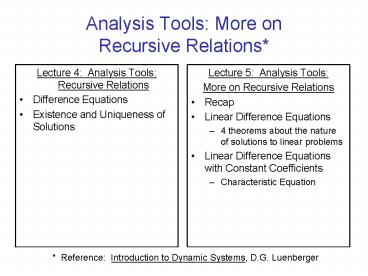Analysis Tools: More on Recursive Relations PowerPoint PPT Presentation
1 / 14
Title: Analysis Tools: More on Recursive Relations
1
Analysis Tools More on Recursive Relations
- Lecture 4 Analysis Tools Recursive Relations
- Difference Equations
- Existence and Uniqueness of Solutions
- Lecture 5 Analysis Tools
- More on Recursive Relations
- Recap
- Linear Difference Equations
- 4 theorems about the nature of solutions to
linear problems - Linear Difference Equations with Constant
Coefficients - Characteristic Equation
Reference Introduction to Dynamic Systems,
D.G. Luenberger
2
Recap from Last Time
- Definitions
- Difference equation
- Linear function
- Linear difference equation
- Order
- Coefficients
- Time-invariant equations
- Forcing term
- Solution
- Theorems
- Structure of a linear difference equation
- Existence and uniqueness of solutions
3
Linear Difference Equations
- A linear difference equation, given by
- is said to be homogeneous if g(k)0 for all k in
the set over which the equation is defined.
Note that 1) The difference of two solutions to
the nonhomogeneous equation must satisfy
the associated homogeneous equation, 2)
The sum of a solution of the nonhomogeneous
equation and a solution of the associated
homogeneous equation is a solution of the
nonhomogeneous equation.
4
Linear Difference Equations
- Theorem 1 (A solution is composed of two parts)
Let y(k) be a given solution to the linear
difference equation - Then the collection of all solutions to this
equation is the collection of all functions of
the form y(k)y(k)z(k), where z(k) is a
solution of the corresponding homogeneous
equation.
5
Linear Difference Equations
- Theorem 2 (Linear combinations of homogeneous
solutions are solutions) If z1(k), z2(k), ,
zm(k) are solutions to the homogeneous equation - then any linear combination of these m solutions
- where c1, c2, , cm are arbitrary constants, is
also a solution of the homogeneous equation.
This theorem says linear combinations of
solutions are solutions, but it does not say all
solutions are found this way.
Proof Do it!
6
Linear Difference Equations
- Define a special set of solutions to the
homogeneous equation corresponding to the n
fundamental initial conditions - Call this set of solutions z1,,zn the
fundamental set of solutions.
...
7
Linear Difference Equations
- Theorem 3 (Every homogeneous solution is a
linear combination of the n fundamental
solutions) If z(k) is any solution to the
homogeneous equation, - then z(k) can be expressed in terms of the n
fundamental solutions, z1(k),,zn(k), of the form - for some constants c1, c2, , cn.
This theorem says all solutions of the
homogeneous equation can be computed from the n
solutions generated by the fundamental initial
conditions.
8
Linear Difference Equations
- Theorem 3 (Every homogeneous solution is a
linear combination of the n fundamental
solutions) If z(k) is any solution to the
homogeneous equation, - then z(k) can be expressed in terms of the n
fundamental solutions, z1(k),,zn(k), of the form - for some constants c1, c2, , cn.
9
Linear Difference Equations
Definition Given a finite set of functions
z1(k),,zm(k) defined for a set of integers,
say k0, 1, 2, , N, we say that these functions
are linearly independent if it is impossible to
find a relation of the form valid for all k0,
1, 2, , N, except by setting c1c2cn0.
- Theorem 4 (any n linearly independent solutions
will do) Suppose z1(k),,zn(k) is a linearly
independent set of solutions to the homogeneous
equation - Then any solution z(k) can be expressed as a
linear combination - for some constants c1, c2, , cn.
10
Linear Difference Equations
- Put it all together for a general method to
solve a nonhomogeneous equation of the form - which satisfies a given set of initial
conditions.
- Find a set of n linearly independent solutions
to - the corresponding homogeneous equation,
- 2) Find a particular solution to the
nonhomogeneous - equation that does not necessarily satisfy the
given - initial conditions, and
- Modify the particular solution by adding a
linear - combination of the homogeneous solutions such
that - the given initial conditions are satisfied.
11
Linear Equations with Constant Coefficients
- For this special case, we can find all solutions
to the homogeneous equation - The key result is that there exists a geometric
sequence that satisfies the homogeneous equation
Characteristic Polynomial
12
Linear Equations with Constant Coefficients
- Fundamental Theorem of Algebra says any
polynomial of degree n has exactly n roots.
Three cases for l - P(l) has distinct roots. General 2nd order
solution given by - P(l) has repeated roots. General 2nd order
solution given by - P(l) has complex roots. Will always appear in
complex conjugate pairs since the coefficients in
the polynomial are real-valued. General 2nd
order solution given by
13
Linear Equations with Constant Coefficients
- Example
14
Linear Equations with Constant Coefficients
- Example (Fibonacci Sequence)

